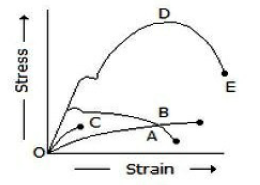The reading of the pressure gauge fitted on a vessel is 25 bar. The atmospheric pressure is 1.03 bar and the value of 'g' is 9.81 m/s2. The absolute pressure in the vessel is
23.97 bar
25 bar
26.03 bar
34.81 bar
Correct Answer :
C. 26.03 bar
Related Questions
The mass of flue gas per kg of fuel is the ratio of the
Mass of oxygen in 1 kg of flue gas to the mass of oxygen in 1 kg of fuel
Mass of oxygen in 1 kg of fuel to the mass of oxygen in 1 kg of flue gas
Mass of carbon in 1 kg of flue gas to the mass of carbon in 1 kg of fuel
Mass of carbon in 1 kg of fuel to the mass of carbon in 1 kg of flue gas
The point of contraflexure is a point where
Shear force changes sign
Bending moment changes sign
Shear force is maximum
Bending moment is maximum
A steel bar of 5 mm is heated from 25°C to 45°C and it is free to expand. The bar will induce
No stress
Shear stress
Tensile stress
Compressive stress
The compression ratio for petrol engines is
3 to 6
5 to 8
15 to 20
20 to 30
If the value of n = 0 in the equation pvn = C, then the process is called
Constant volume process
Adiabatic process
Constant pressure process
Isothermal process
Diesel cycle consists of __________ processes.
Two constant volume and two isentropic
Two constant pressure and two isentropic
Two constant volume and two isothermal
One constant pressure, one constant volume and two isentropic
Strain is equal to (where l = Original length, and δl = Change in length)
l/δl
δl/l
l.δl
l + δl
A close cycle gas turbine gives __________ efficiency as compared to an open cycle gas turbine.
Same
Lower
Higher
None of these
The ratio of specific heat at constant pressure (cp) and specific heat at constant volume (cv) is always __________ one.
Equal to
Less than
Greater than
None of these
The extension of a circular bar tapering uniformly from diameter d₁ at one end to diameter d₂ at the other end and subjected to an axial pull of P is given by
δl = 4PE/ πl²
δl = 4πld²/PE
δl = 4Pl/πEd₁d₂
δl = 4PlE/ πd₁d₂
The ideal efficiency of a Brayton cycle without regeneration, with increase in pressure ratio will
Increase
Decrease
Remain unchanged
Increase/decrease depending on application
Euler's formula holds good only for
Short columns
Long columns
Both short and long columns
Weak columns
In the below figure, curve D represents_________.

Mild steel
Cast iron
Concrete
Bone of these
When a gas is heated at constant volume
Its temperature will increase
Its pressure will increase
Both temperature and pressure will increase
Neither temperature nor pressure will increase
A key is subjected to side pressure as well at shearing forces. These pressures are called
Bearing stresses
Fatigue stresses
Crushing stresses
Resultant stresses
The maximum diameter of the hole that can be punched from a plate of maximum shear stress 1/4th of its maximum crushing stress of punch, is equal to (where t = Thickness of the plate)
t
2t
4t
8t
The stress induced in a body due to suddenly applied load compared to when it is applied gradually is
Same
Half
Two times
Four times
The general law for the expansion or compression of gases, is
pv = C
pv = m R T
pvn = C
pvγ = C
The value of specific heat at constant pressure (cp) is __________ that of at constant volume (cv).
Less than
Equal to
More than
None of these
A cantilever beam is one which is
Fixed at both ends
Fixed at one end and free at the other end
Supported at its ends
Supported on more than two supports
Proof resilience per material is known as
Resilience
Proof resilience
Modulus of resilience
Toughness
The following cycle is used for air craft refrigeration
Brayton cycle
Joule cycle
Carnot cycle
Reversed Brayton cycle
Stirling and Ericsson cycles are
Reversible cycles
Irreversible cycles
Semi-reversible cycles
Quasi-static cycles
Which of the following is the extensive property of a thermodynamic system?
Pressure
Volume
Temperature
Density
The throttling process is __________ process.
Reversible
Irreversible
Reversible or irreversible
None of these
The processes occuring in open system which permit the transfer of mass to and from the system, are known as
Flow processes
Non-flow processes
Adiabatic processes
None of these
A coil is cut into two halves, the stiffness of cut coil will be
Double
Half
Same
None of these
The fuel mostly used in blast furnace for extracting pig iron from iron ores is
Hard coke
Soft coke
Pulverised coal
Bituminous coal
A cycle consisting of two adiabatic and two constant pressure processes is known as
Otto cycle
Ericsson cycle
Joule cycle
Stirling cycle
If a part is constrained to move and heated, it will develop
Principal stress
Tensile stress
Compressive stress
Shear stress
